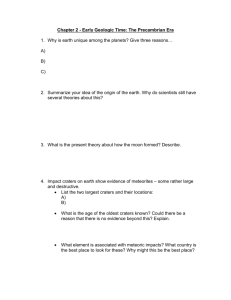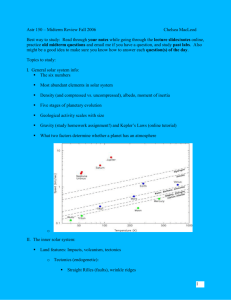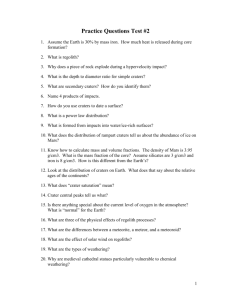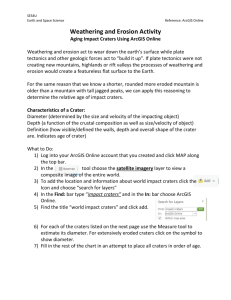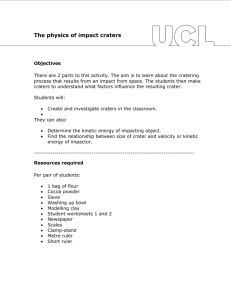Terrestrial Planets: Surfaces
advertisement
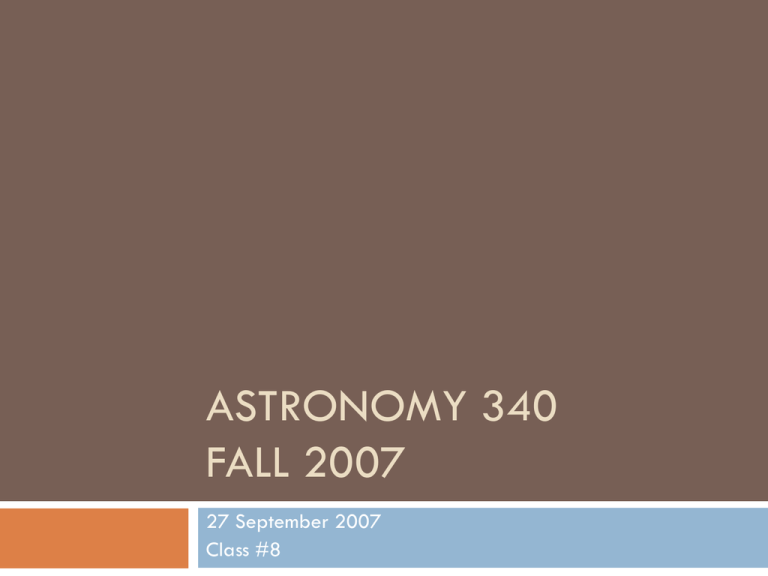
ASTRONOMY 340 FALL 2007 27 September 2007 Class #8 90 minutes of homework (for 6th graders, but you can extrapolate to college…) 15 minutes looking for assignment 11 mins calling a friend for the assignment 23 mins explaining to parents why the teacher is mean and just doesn’t like children 8 mins in the bathroom 10 mins getting a snack 7 mins checking the TV guide 6 mins telling parents that the teacher never explained the homework 10 mins sitting at the kitchen table waiting for Mom to do the assignment Review CO molecule – Rayleigh-Jeans approximation substitute temperature for intensity in radiative transfer eqn. Tb = (λ2/2k)Bλ Tb(s) = Tb(0)e-τ(s)+T(1-e-τ(s)) Planetary Surfaces Processes at work: impact, weathering, atmosphere, geology (tectonics/volcanic Mercury: heavily cratered, no tectonics Venus: global resurfacing 300 Myr ago, no tectonics Mars: water, older volcanoes Earth: tectonics, water, weather Volcanic Activity Key ingredient molten material Accretion Impact Tidal (primordial heat) triggered heating/stretching Radioactive decay Lunar mare – resurfacing via some Impact that releases magma. Lunar Mare Note low crater density. Volcanic Activity Key ingredient molten material Accretion (primordial heat) Impact triggered Tidal heating/stretching Radioactive decay ρ(magma)<ρ(rock) magma rises through “plumes” volcanoes sit atop plumes same physics on any planet/moon Magma acts to resurface Volcanic composition H2O, CO2, SO2 (recall that Io has SO2 or S2 gas) Venus’ Tectonic Activity? Smrekar & Stefan 1997 Science 277, 1289 Venus’ past Crater distribution is even & young no resurfacing over past 300-500 Myr (Price & Supper 1994 Nature 372 756) No global ridge system and a lack of significant upwellings (Solomon et al. Science 252 297) Why such a big difference compared with Earth? Catastrophic loss of H2O from mantle? no convection “coronae” are unique to Venus rising plumes of magma exert pressure on lithosphere less dense lithosphere deforms under pressure deformation of crust without tectonics Martian Tectonic Activity Connerney et al ’99 Science 284 794 Mars Global Surveyor Detected E-W linear magnetization in southern highlands “quasi-parallel linear features with alternating polarity” Note: Earth’s global B-field is so much stronger it makes crustal sources hard to detect Martian Tectonic Activity Connerney et al ’99 Science 284 794 Mars Global Surveyor Detected E-W linear magnetization in southern highlands “quasi-parallel linear features with alternating polarity” Note: Earth’s global B-field is so much stronger it makes crustal sources hard to detect Mars has no global field so crustal field must be remnant (“frozen in time”) from crystallization Martian Crustal Magnetization Working model Collection of strips 200 km wide, 30 km deep Variation in polarization every few 100 km 3-5 reversals every 106 years (like seafloor spreading on Earth) Some evidence for plate tectonics…but crust is rigid Earth’s crust appears to be the only one that participates in convection Impacts and Cratering Dominates surface properties of most rocky bodies “Back of the envelope” calculation of the energy of an impact… Formation of Impact Craters Impactor unperturbed by atmosphere Impact velocity ~ escape velocity (11 km s-1) tens of meters in diameter Impact velocity > speed of sound in rocks impact forms a shock ~100 times stress levels of rock impact vaporizes rocks Pressures Shock velocity ~10 km s-1 much faster than local sound speed so shock imparts kinetic energy into vaporized rock Contact/Compression Projectile stops 1-2 diameters into surface kinetic energy goes into shock wave tremendous pressures P ~ (1/2)ρ0v2 Peak shock pressures ~1000 kbar; pressure of vaporization ~600 kbar Shock loses energy Radial dilution (1/r2) Heating/deformation of surface layer Velocity drops to local sound speed – seismic wave transmitted through surface Can get melting at impact point Shock wave reflected back through projectile and it also gets vaporized Total time ~ few seconds Excavation Shock wave imparts kinetic energy into vaporized debris excavation of both projectile and impact zone (defined as radius at which shock velocty ~ sound speed (meters per second) Timescale is just a dynamical/crossing time (t = (D/g)1/2 Crater size? D goes as E1/3 empirically, it looks like ~ 10 time diameter of projectile (but see equation 5.26b). Can get secondary craters from debris blown out by initial impact Large impacts multiring basins (Mars, Mercury, Moon) Craters 35m 2m 4yr 1km 50m 1600yr 7km 350m 51,000yr 10km 500m 105 yr 200km 10km 150 Myr Small Earthquake Barringer Meteor Crater 9.6 mag earthquake Sweden Largest craters/KT impactor Crater Density See Figure 5.31 in your book number of craters km-2 vs diameter Saturation equilibrium – so many craters you just can’t tell…. Much of the lunar surface Almost all of Mercury Only Martian uplands Venus, Earth not even close note cut-off on Venus’ distribution Calibrate with lunar surface rocks 107 times more small craters (100m) as there are large craters (500-1000 km) Mercury South Pole Lavinia Planum Impact Craters Note ejecta surrounding crater “It’s the size of Texas, Mr. President” - from yet another bad movie Comets – small,rocky/icy things 10s of km Asteroids – small, rocky things a few to 10s of km the largest is the size of Texas (1000 km) 100-300 NEAs known Close encounters…. River in Siberia 30-50m meteroid exploded above ground flattened huge swath of forest Tunguska You make the catastrophe… Need high velocity Make it big…. max velocity ~ 70 km s-1 (combine Earth’s orbital velocity plus solar system escape velocity) Earth-asteroid encounters 25 km s-1 Eart-comet encounters 60 km s-1 E ~ mv2 something 1000 km would wipe out the entire western hemisphere, but let’s be realistic and go for ~10m (1021 J) or ~1 km (1023 J) One impact imparts more energy in a few seconds than the Earth releases in a year via volcanism etc.
